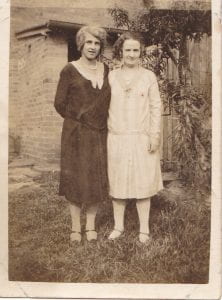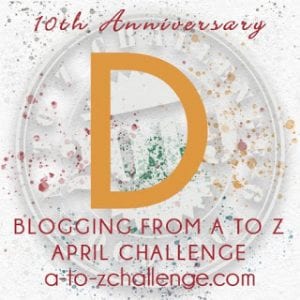 First cab off the rank for the 2020 A to Z Challenge is Alice Maud Coxon. Now, A is always an easy letter as so many names start with A and the individuals in my tree were no exception. But the hardest choice was who to choose to write about. All up, there are 252 individuals in my tree who have a first name starting with A. I chose Alice Maud for a few reasons, but the main reason is that I have a fair amount if information about her, both factual and anecdotal, and she’s always intrigued me from what I’ve heard about her.
First cab off the rank for the 2020 A to Z Challenge is Alice Maud Coxon. Now, A is always an easy letter as so many names start with A and the individuals in my tree were no exception. But the hardest choice was who to choose to write about. All up, there are 252 individuals in my tree who have a first name starting with A. I chose Alice Maud for a few reasons, but the main reason is that I have a fair amount if information about her, both factual and anecdotal, and she’s always intrigued me from what I’ve heard about her.
First, the factual information. Alice was my great, great grandmother on my Father’s side and was born 27 September 1889 in West Maitland, NSW to parents Thomas Coxon, a coal miner who worked at nearby Four Mile Creek, and Elizabeth Robins. Alice was the youngest of six children born to the couple, and grew up in and around the East Maitland area. By the time she was 21 she was living at New Lambton, where she married her husband Matthew Iles. Alice and Matthew went on to have four children over the next eight years. So, there’s some bare facts about Alice. But what makes her so interesting to me?
When I first came across Alice, she was just a name on a piece of paper to me and I didn’t know much more about her than that. When I first started tracing my family tree, I took the direct approach and just followed the direct ancestors as far back as I could manage. However, as time went on I became interested in investigating some so-called ‘collateral’ ancestors. Now, as I already noted Alice had four children over eight years with her husband Matthew: Matthew Vernon Lorraine (my great grandfather); Hilton; Eunice and Kiffin. Now, that is all very unremarkable but what is remarkably sad to me is that after just eight years of marriage, Matthew unexpectedly died.
Matthew had been a railway worker throughout the entire time of their marriage, working variously as a traffic signaller, a porter and a night guard. It was a good, solid job and would have provided a reasonable income on which to support his family. Even better, being employed on the railways meant he was in a reserved occupation so spent the years of WWI at home in Australia rather than heading overseas. But by 1918 Matthew was dead from Tetanus and Toxaemia, leaving Alice with four children under the age of 8 years old. At the time of her husband’s death, Alice’s children were 7, 5, 3 and 16 months.
When I first found out this information, I thought about how sad it was but at the time didn’t give it much thought. It was only later as I spent some time talking with my great-uncle about his collection of family photos that I started to see her as an actual person. Alice had been his grandmother after all and he recalled his father talking a lot about her and he shared some interesting things with me.
Apparently, after her husband’s death the NSW Railway generously offered Alice a position working as a station attendant. This was explained as quite generous by the Railways at the time as women with young children didn’t typically work outside of the home. Alice continued to work for the Railways for many years, eventually moving from just a general station attendant to being an attendant in the refreshment rooms. To date, I have not been able to locate her Railway Personnel records to glean any more information about her employment but the electoral rolls have confirmed that she did in fact work for the railways.

Alice Iles (nee Coxon) on the right.
But the sadness didn’t end with just her husbands death. In 1920, just two years after her husband’s death, Alice lost her daughter Eunice who was aged only five years old at the time. Now, this one really broke my heart and I can vividly remember having tears in my eyes as I read the death certificate. At the age of only five years old, Eunice had died from Measles. She had suffered for 5 days from Measles, but the part that really got me teary was the fact that she had suffered from convulsions for 4 hours as a result of the disease.
Now, I don’t have children but for many years I worked with children and during my training I can remember doing a unit in infectious diseases and we watched some confronting videos on what diseases like measles can do to young children who aren’t vaccinated. And so, I could vividly picture in horrifying detail the violent convulsions that she probably suffered.
It then got me to thinking about the rest of Alice’s life and how little I knew about it. I researched her siblings and parents and found out one more sad fact. In 1893, when Alice was only 4 years old, her mother Elizabeth died. Just four years later her father Thomas also died, following a mining accident. At the time that her mother died, Alice’s eldest sister Florence was 16 years old. Being the eldest sister and of an age to be able to run the home, one can only assume that Florence would have taken over the running of the house and care of her father and younger siblings after the death of her mother. What happened to the younger children when their father died, I don’t know as neither of the two eldest children were over the age of 21.
What I do know is that Alice was obviously close to her sister Florence, who never married. When Alice died in 1958 at the age of 68 years old, she was buried in the same plot as her sister Florence who had died just three years earlier in 1955.

Inscription reads: In Loving Memory of Our Dear Mother Alice Maud Iles.



